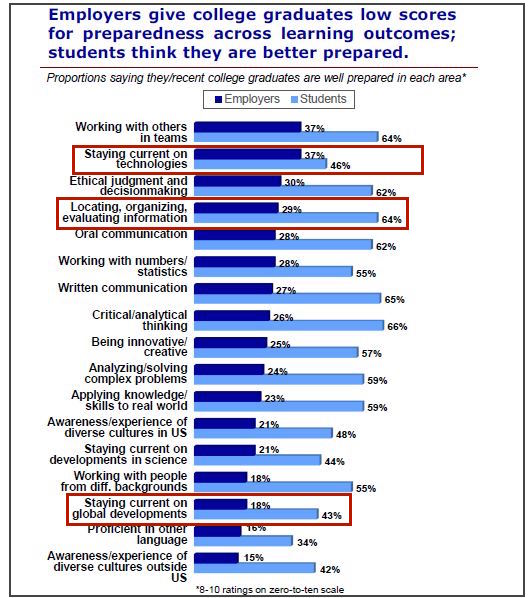 “Digital technology is an ally for higher education” —Professor Mary McAleese, Teaching and Learning in Irish Higher Education (2015)
“Digital technology is an ally for higher education” —Professor Mary McAleese, Teaching and Learning in Irish Higher Education (2015)
Most educators today possess the digital skills needed to function in academic life. There’s the basics—managing email, using the Learning Management System (LMS), uploading papers to plagiarism checkers among others. Yet some faculty still struggle with basic LMS functions (Straumsheim, Jaschik & Lederman, 2015). Then there’s the ever-expanding array of apps, online platforms, collaborative digital tools to consider and the latest trend—messaging platforms that are replacing traditional methods of communication like email and face-to-face meetings. The skill level that’s required of faculty to keep current with the changes in technology is expanding. There’s a gap between existing skills and what’s needed; there’s a pressing need for educators to learn how to harness the best of digital technology in order to remain relevant, improve leaning outcomes for students and to manage their teaching practice efficiently and effectively. But it’s not just faculty lacking digital skills.
The Student Skills Gap
Intuitively we think it’s faculty over students who need the most support for expanding their digital capacity. It’s tempting to say so when students appear more tech savvy than us. Though students may have mastered social media quite well they lack the breadth and depth of skills to thrive in a global economy where there’s an abundance of knowledge and digitization is transforming business and social institutions. A survey by the Association of American Colleges and University lays bare skills students lack. Employers and college students surveyed on their perceptions of how prepared college graduates were for the workplace reveal that students lack skills in: i) locating, organizing and evaluating information, ii) staying current on technologies and iii) staying current on global events; a significant shortfall (chart below).
The Skills Needed
What then is the answer? I suggest the skills gaps need to be addressed at the institutional level for students and educators. The goal should be for students and faculty to thrive in a digital and social economy. The starting point for closing the gap is articulating what faculty and students should be able to do; what digital skills they need to thrive.
Below are lists of digital skills for both students and faculty. They are designed as starting points; the goal is to get institutions thinking about how to raise the skill level of their students and faculty. The lists are inspired from a variety of sources: i) OECD’s Ministerial Declaration on the Digital Economy; a set of recommendations established by the group of 41 countries to support the recent (and significant shift) to a digital economy and a handful of reports surveying faculty digital skill level (Straumsheim et al. 2015, Wise & Meyer, 2016).
Digital Skills Required of Students in order to:
- Locate, curate and organize digital information for academic, personal and/or professional use
- Create digital web content, websites, blogs, artifacts etc. to communicate concepts and messages effectively
- Discern credible news from digital sources to keep current on scientific, business and political events from the global to community level
- Leverage employment opportunities and explore career paths across digital platforms
- Participate in professional development and lifelong learning using online platforms and digital applications
- Contribute to and engage in community and national events, causes and initiatives
- Protect digital identify and privacy, determine how personal data is used and protect accordingly
- Create and participate in a personal learning network leveraging digital platforms
Digital Skills Required of Faculty/Teachers in order to:
- Locate, curate and organize digital information for academic, personal and/or professional capacities
- Leverage digital tools and online platforms following sound pedagogically principles to support student learning
- Locate and implement open education resources to support student learning
- Use digital tools, platforms and institution’s learning management system (LMS) to support efficient and effective teaching activities
- Use LMS and other platform data to identify students requiring additional services and learning support (services provided by institution or faculty)
- Participate in professional development and lifelong learning using online platforms and digital applications
- Create and participate in a personal learning network leveraging digital platforms
A Digital Framework In Action
As mentioned, the aim of this post is to get institutions thinking about creating their own framework and strategy for building the digital capacity of faculty and students. Many are already well on their way. A group of universities in Ireland for example have built a digital skills framework, All Aboard, an initiative funded by Ireland’s National Forum for the Enhancement of Teaching & Learning in partnership with a handful of universities. The goal of the program “to increase digital capacity, not only of students but teachers and staff, by empowering students and their educators to flourish in digital world”. They’ve created an interactive map modeled after a metro map that sorts the competencies of major skill sets into branches, where branches are like routes on a subway. For example there’s Tools and Technologies skill area (grey), Teach and Learn, (blue) and Identity and Well being (black). Along the route of each branch, are sub-sets of skills that support each skill area.
 This type of visual map is a good tool; it makes sense of the breadth and depth of skills needed for digital proficiency. It’s a good starting point for the novice outlining the skill paths, but it still serves as a tool for planning and organizing how to advance the experienced person’s skills, or for developing a framework for professional development.
This type of visual map is a good tool; it makes sense of the breadth and depth of skills needed for digital proficiency. It’s a good starting point for the novice outlining the skill paths, but it still serves as a tool for planning and organizing how to advance the experienced person’s skills, or for developing a framework for professional development.
Closing
Closing the digital skill gap for faculty and students appears a daunting task—daunting, but not impossible. The starting point is determining the skills needed then creating a plan to tackle each, ideally within a framework as the All Aboard initiative did. Easier said than done, but it’s critical for supporting faculty and college graduates so both groups can thrive in a digital world.
References
- All Aboard: Project Overview. (n.d.). Retrieved from http://allaboardhe.org/
-
Digital Economy Ministerial Meeting – Organisation for Economic Co-operation and Development. (n.d.). Retrieved from http://www.oecd.org/internet/ministerial/
- Hart Research Associates. Falling Short? College Learning and Career Success. Rep. Washington DC: Association of American Colleges & Universities, 2015. Retrieved https://www.aacu.org/leap/public-opinion-research/2015-survey-falling-short
- How the digital skills gap is failing higher education and how to close it (Rep.). (2015, February 15). Retrieved http://www.slideshare.net/GoGrovo/how-4466024
- Straumsheim, C., Jaschik, S., & Lederman, D. (2015). 2015 survey of faculty attitudes on technology (Rep.). Gallup and Inside Higher Ed. Retrieved from https://www.insidehighered.com/audio/2015/11/12/2015-survey-faculty-attitudes-technology
- The Digital Skills metro map is now interactive! (n.d.). Retrieved from http://allaboardhe.org/digital-skills-framework/
-
Wise, S., & Meyer, M. (2015). Teaching and Learning with Technology. Retrieved http://www.colorado.edu/assett/sites/default/files/attached-files/final-fac-survey-full-report.pdf















